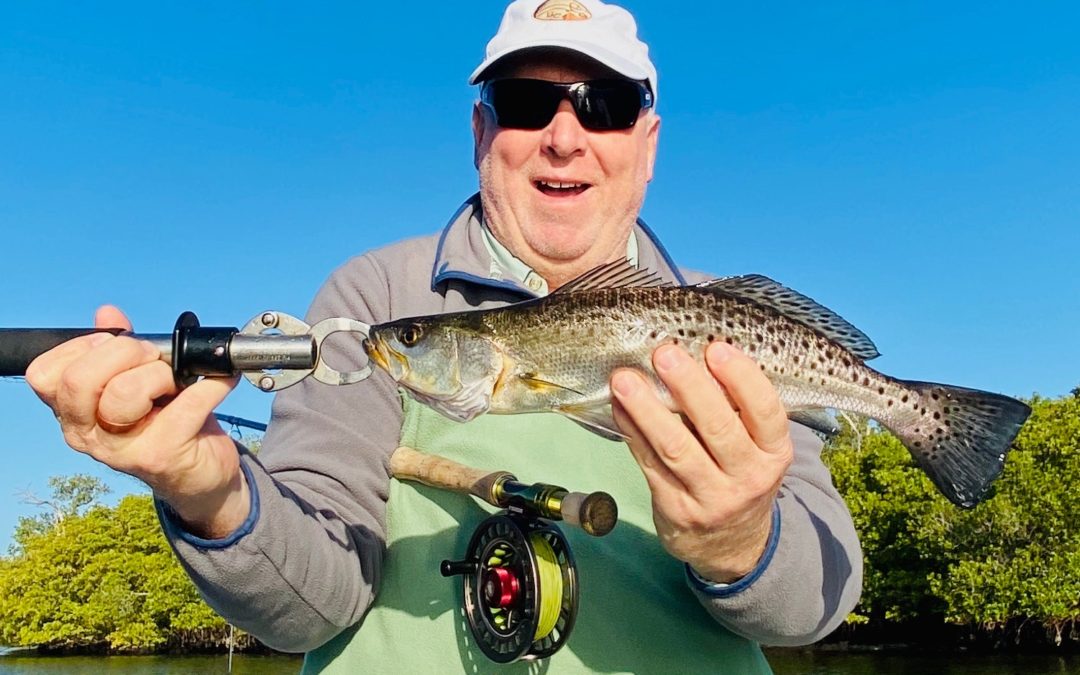For the most part, in and around the Charlotte Harbor area, the spotted sea trout doesn’t get a whole lot of respect. I guess when you take into consideration the snook, redfish, and tarpon fisheries that we are so fortunate to have; the trout are definitely a bit overshadowed. It isn’t like this everywhere, in fact, in some parts of the country the sea trout is even more popular than the redfish. I actually got to see this first hand a couple of years ago when Jay and I were fishing a redfish tournament out of Gulf Shores Alabama. We made the run from Gulf Shores all the way to Pascagoula Mississippi where we knew there were some plump redfish hanging out. While there, we noticed this small green sort of camouflaged boat that was taking the time to visit with every boat in sight. As they managed their way over to the Pathfinder, I was able to distinguish the pistols on their belts and it became evident they were the local game wardens. Well anyway, of course we were obeying the law. In fact, we had three big redfish in the live well, the bag limit is three per angler, but all the game warden wanted to know was how many trout we had in the boat. After he saw that we had no trout, he was out of there. As it turned out, just about every boat in the river system was targeting trout. By the way, the daily bag limit on trout in Mississippi is 15 per angler.
For what it’s worth, the spotted sea trout is not really a trout at all. It is in fact a species of croaker. And just like other fish in the species, they can and will produce a sort of croaking or drumming sound. However, that is not really all that important. What is worth keeping in mind is that the spotted sea trout is pretty much an abundant fish with what could be considered a cooperative or an aggressive nature that can be easier to locate as well as keep track of than some of the more glamorous species. This all adds up to a fish that is tailor made for a simple day of family fun.
Particularly this time of year, spotted sea trout tend to be one of the more active species as they can tolerate water temperatures that slowly drop into the lower 50’s. When other species are hunkered into deeper holes trying to stabilize their metabolisms, the sea trout can still move around the grass flats. Even better, they also tend to be creatures of habit in that they typically won’t travel any more than about five miles from the spot they were born. So, if you find some trout on any given day, there is a good chance that they won’t be too far off next time you go out. They primarily relate to and like to hang out around sea grass with turtle grass being one of their favorites.
In short, look at fishing for the spotted sea trout as fulfilling sort of a different role or purpose than targeting a snook or redfish. Like, say if you have only a morning or an afternoon and you want to put in some easy fishing with the family. Sometimes, schools of accommodating fish that are not too picky about what they eat are just the ticket. Maybe, if we got some of the bigger gator size trout that roam places like the Mosquito lagoon and Indian River we would spend more time chasing them down, but then we should feel fortunate for the great fishery that we already have. Besides, if we wait about another month when the whitebait begins to pour back into the harbor we might just get the chance to fish for some of the biggest trout all year as some of the grass flats closest to the pass like those around both Bokeelia and Devilfish Key should be holding some nice fish.
As a final thought, if you have ever handled a trout then you know how slimy they can be. This is probably one reason lots of anglers would prefer not to mess with them. It is however this slime coat that helps protect the fish, so if you are not planning on keeping a particular fish it is best to release the fish without ever taking it out of the water. This will both make your day more enjoyable, and will of course, do less harm to the fish


Recent Comments